
Pelosi and Trump: Choreographies of conflict
The Pelosi-Trump conflict has been documented in a series of photographs. In our media culture, images are emblematic when they are sensed to tell the full story. This has been the case ever since photography became a fully integrated part of journalism, and some historic photos have entered our collective memory - think of Robert Capa's image of a falling soldier during the Spanish civil war, or Eddie Adams' photo of the summary execution of a North Vietnamese fighter in the streets of Saigon. In the digital era, in which unprecedented volumes of pictures are made and circulated, emblematic images have become even more important. Let us examine a case.
The Pelosi-Trump conflict
US President Donald Trump and Nancy Pelosi don't get along too well. Pelosi, a member of the Democratic Party, became Speaker of the House of Representatives in January 2019 and quickly assumed the leadership of the political opposition against Donald Trump, something that reached a peak during the impeachment procedure against Trump in late 2019-early 2020. According to the US Constitution, the Speaker of the House is the number three of the US political regime, after the President and the Vice-President; Pelosi's overt conflict with the President is therefore a matter of some importance.
Outright hostility and mutual "dissing" remain quite exceptional among politicians in such senior functions.
Naturally, politicians are not expected to agree with each other, certainly not when they represent different parties. But outright hostility and mutual "dissing" remain quite exceptional among politicians in such senior functions (at least, until Donald Trump came along). After all, such functions come, conventionally, with a huge load of expectations and constraints of decorum, procedural correctness and collegial politeness. Little of that can be observed in the ways in which Pelosi and Trump interact with each other and about each other. The Pelosi-Trump conflict, consequently, has drawn a lot of attention and made news headlines around the world on several occasions.
There is no need here to enter into the causes and details of this conflict; I will focus on how it is given shape in a number of emblematic images, all of which went viral and became the raw material for widely circulating memes.
Pelosi vs Trump: Choreographies of conflict
There are four moments in the conflict that were documented in emblematic images. All of these images show clearly 'readable' and recognizable body language pointing unambiguously towards conflict. The first moment was a White House meeting in May 2019 opposing Trump and his Vice-President Pence to Pelosi and the Democratic Minority Leader of the US Senate Chuck Schumer. The topic of the meeting was a budget proposal by Trump, and the Democrats clearly offered strong opposition to it.
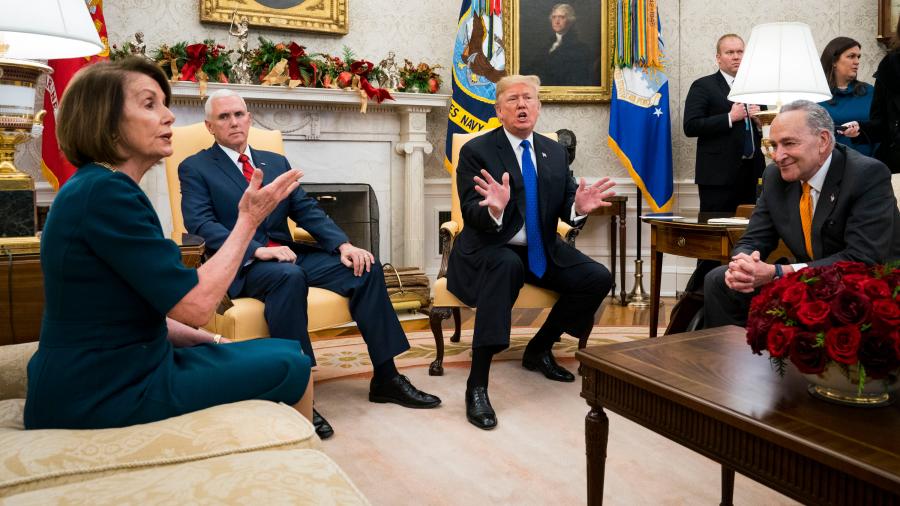
May 2019 meeting
We see a choreography of conflict here: the signs we can read from the simultaneous body movements captured in the picture tell us that Pelosi and Trump are interrupting each other - something that violates the etiquette of sequentiality in polite conversation and usually signals a fight between people. The image becomes readable as a shouting match between Pelosi and Trump, with Pence and Schumer as passive bystanders.
Importantly, while these images obviously document a political conflict, the gestures caught in the picture are recognizable as features of everyday interpersonal conflicts - they index people deeply disliking each other and, consequently, enable us to personalize a political conflict. After all, we can imagine or recall everyday situations in which we used such gestures or were the target of such gestures. In that sense, the picture offers at least two simultaneous lines of interpretation: one focused on the political issues, another focused on the personalities and character of the protagonists, Pelosi and Trump.
This choreography of interpersonal conflict is even more pronounced in the second moment: an October 2019 meeting in the White House in which the Democratic leadership opposed Trump's surprise decision to withdraw US troops from Syria.
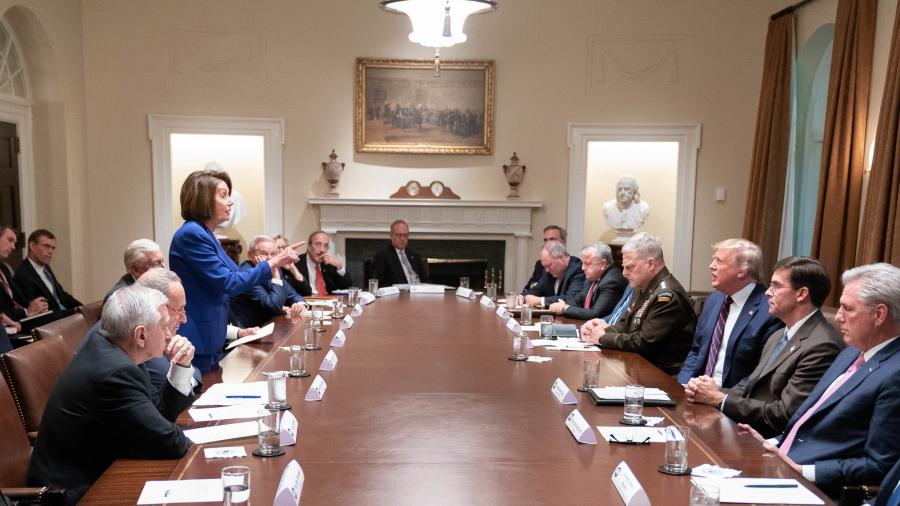
October 2019 meeting
In this picture, Pelosi stands while all others are seated, and she points a finger at Trump (who appears to offer verbal retaliation). There is a reason why the expression "pointing fingers" has a pejorative ring to it and suggest an offensive allocation of blame. The reason is that the actual physical gesture of pointing a finger directly at someone is widely understood as a form of aggression, as a threat or menace, and usually also indicates dominance. And this is what Pelosi does here, pointing her finger directly at Trump (her Head of State, remember), dominating him and the other people on Trump's side of the table (whose body language is also quite explicit - bowed heads, clasped hands). Trump, in this picture, is in a defensive position looking up at Pelosi. And again, we can see these gestures as indices of a personal conflict.
In all four moments, the images capture a single instant in which particular gestures can be seen to tell a big story: one of overt hostility between two of the most senior politicians in the US
Rarely, a political conflict was more tellingly documented. And evidently, Trump would try to reverse the roles we can read from the picture in a tweet soon after the meeting - confirming and illustrating his defensive position in the picture. Note again the personalization of the conflict: he talks about Pelosi's state of mind.
Trump tweet, October 2019
The two other moments both refer to State of the Union speeches given by Trump in February 2019 and 2020 respectively. The State of the Union is delivered to the entire Congress - the House and the Senate - and the session is presided by the Vice President (representing the Senate) and the Speaker of the House. In 2019, Pelosi performed what was widely interpreted as "sarcastic clapping" after Trump's speech. This image went viral.
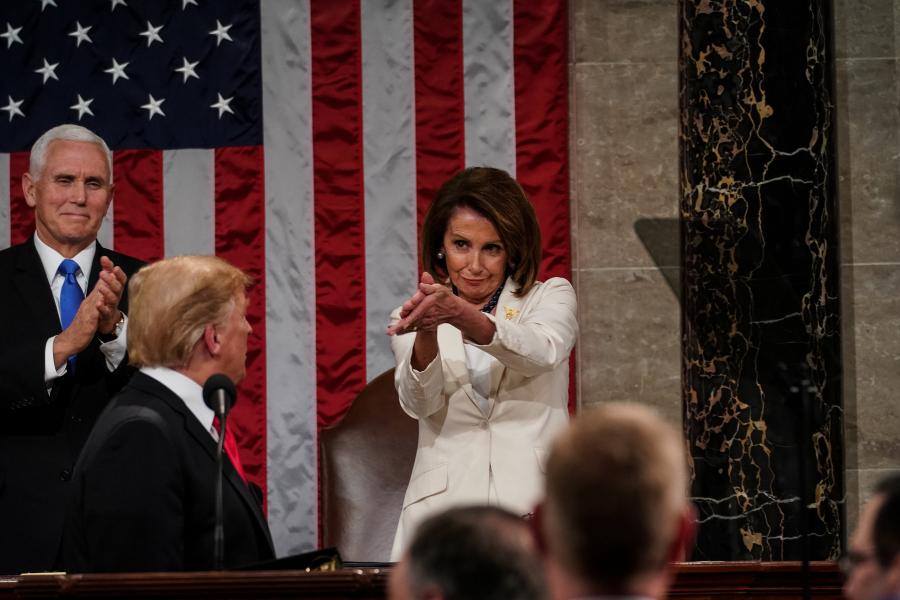
State of the Union 2019
In February 2020, she took things to the next level. At the end of Trump's speech, she publicly tore up the copy of the speech she had received at the start of the session, later declaring that she didn't tear up the State of the Union speech but Trump's "state of mind address". Here too, the political conflict is accompanied by personalization.
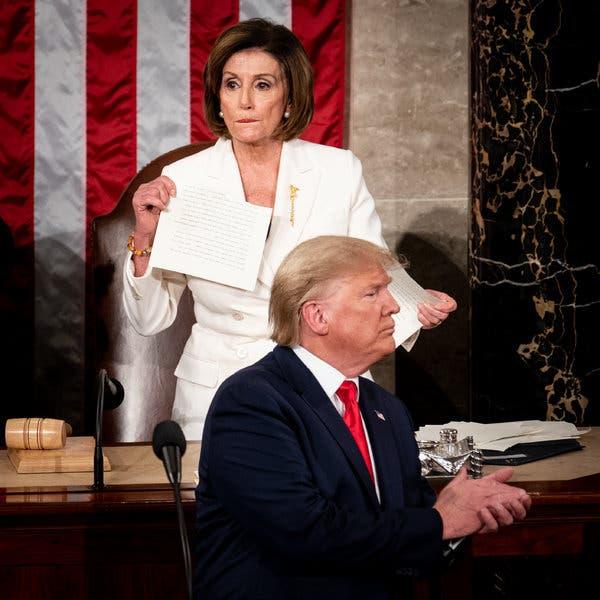
State of the Union 2020
This dramatic gesture at the end of the session - again, readable as a form of aggressive, offensive behavior directed at the Head of State - was preceded by another one, at the start of the session;
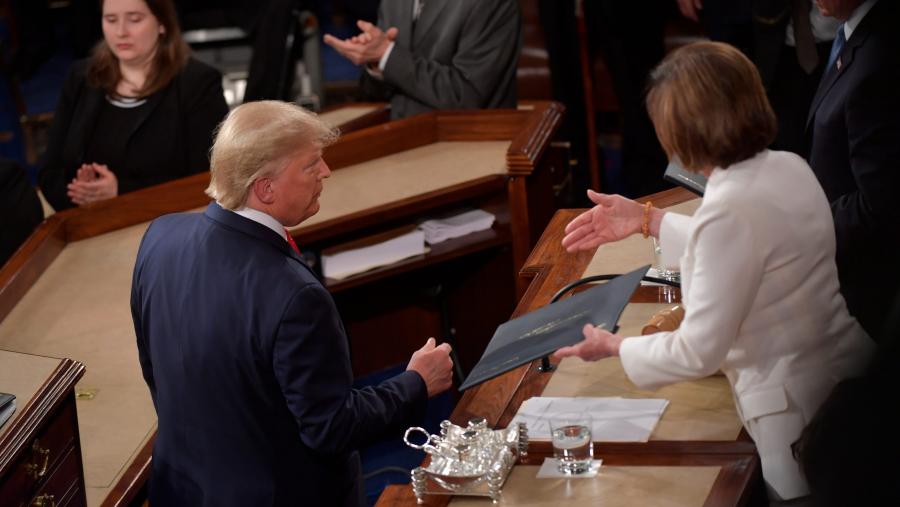
Trump refusing to shake hands
Trump, after handing the copies of his speech to Pence and Pelosi, refused to shake Pelosi's hand. And that gesture, of course, is a typical feature of intense interpersonal conflict and a violation of the most elementary rules of polite public behavior. It allows inferences about Trump being a vindictive bully, and the gender dimension of the scene also invites unpleasant sexist interpretations.
In all four moments, the images capture a single instant in which particular gestures can be seen to tell a big story: one of overt hostility between two of the most senior politicians in the US, out in the open and visible to all. They are emblematic because they summarize this story and appear to us as key incidents from which much more can be inferred - about the people involved, about the political issues fueling the conflict (all four moments occurred during stages in the impeachment process against Trump), about the foundations of democratic governance even. And commentators in mainstream media across the world explained these moments from all these angles.
From MSM reports to memes
There can be no surprise: these emblematic images were quickly turned into memes. Several online fora documented the memification of the conflict, starting already as soon as Pelosi became the Speaker of the House, and culminating with what came to be known as "Pelosirip memes".
The effect of such memes is, of course, an expansion of the exposure of the original image.
Pelosi's appointment instantly led to memes anticipating her conflict with Trump. Here is an example.
She's right behind me
And the State of the Union incidents, of course, generated tons of memes, some directly connected to the political tension documented in the images, others just ludic transformations converting the political-conflictual message into more generalizing interpretations of character - the personalization effect mentioned earlier - and into more anodyne real-life contexts. Here is an example of the former.
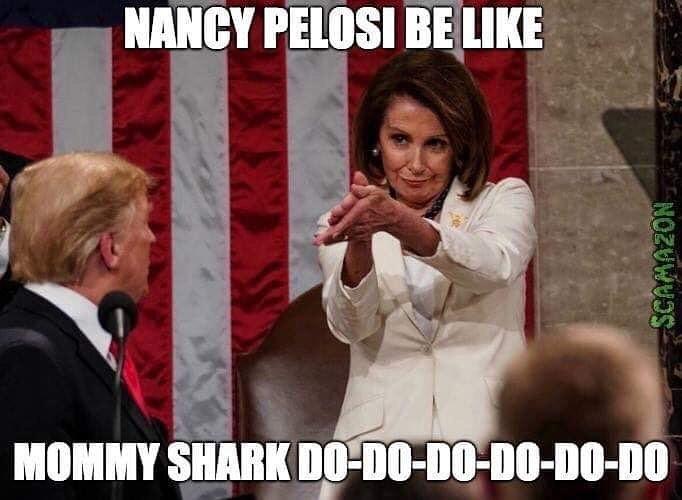
clapping meme
And look at how the tearing up of Trump's speech was turned into a passe-partout meme articulating everyday recognizability:
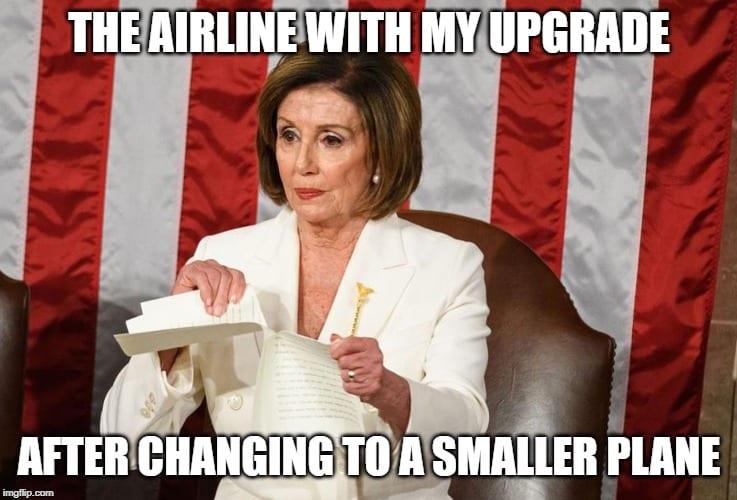
Pelosirip meme
The ways in which such images were instantly absorbed into online meme culture is eloquently illustrated in the following meme, in which one of the images discussed above is presented as a "real life" instance of a widely circulating popular meme.
Dank meme real life
The effect of such memes is, of course, an expansion of the exposure of the original image, which now morphs into cultural material applicable to a huge variety of real-life situations while it maintains its original emblematic meanings. And we begin to see why images such as the ones discussed here are memetic material par excellence. It is because they are emblematic, because they tell a big story on the basis of the readability of gestures and widespread normative understandings of what these gestures mean in our sociocultural universes.
Choreographies such as the ones captured in these images of Pelosi and Trump caught in fights are so transparent as images of common human social behavior that they can be infinitely transformed and expanded into other domains of life and used to identify personality features of individual people. Perhaps this is a pretty precise description of what goes on in the "culture wars".